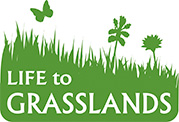You are warmly invited to visit the LIFE project exhibition, organised within LIFE Capacity Building Slovenia project. This time, you can learn more on dry grasslands, protected within LIFE TO GRASSLANDS project. The exhibition will be on display at the Ministry of the Environment and Spatial Planning (Dunajska 48, Ljubljana) until February 28, 2019.

The project entitled “Conservation and management of dry grasslands in Eastern Slovenia” or shorter LIFE TO GRASSLANDS started in November 2015 and will be completed in October 2021. The project is aiming at improving the condition and ensuring long-term management of dry grasslands and related plant and animal species on four project sub-areas: Haloze, Pohorje, Kum and Gorjanci (Natura 2000 sites). All four areas face the problems of overgrowing and abandonment of agricultural use on one hand, and inadequate, pre-intensive agricultural use on the other. During the project, the status of two Natura 2000 priority habitat types of grassland in unfavourable condition is being improved: semi-natural dry grasslands and scrubland facies on calcareous substrates, which are important orchid sites, and species rich Nardus grasslands, on siliceous substrates in mountain areas (and submountain areas in Continental Europe). The LIFE TO GRASSLANDS project also contributes to the implementation of the Natura 2000 Site Management Program (2015 to 2020).
The improvement is being achieved through a number of activities, from the active involvement of landowners in the management of dry meadows and the promotion of grazing, mowing of abandoned land, to actively removing the overgrowth on agricultural land, training and preparation of expert bases for the agro-environmental programme and farm plans for interested farmers.
The project is implemented by the Institute of the Republic of Slovenia for Nature Conservation in cooperation with the Gorjanci Mown Grasslands Society, the Agriculture and Forestry Institute Ptuj, Dobovec Local Community and PRJ HALO, Haloze Rural Development Centre. The value of the project is EUR 3.9 million, of which almost three million is contributed by the LIFE programme. The project co-finances also the Ministry of the Environment and Spatial Planning.






